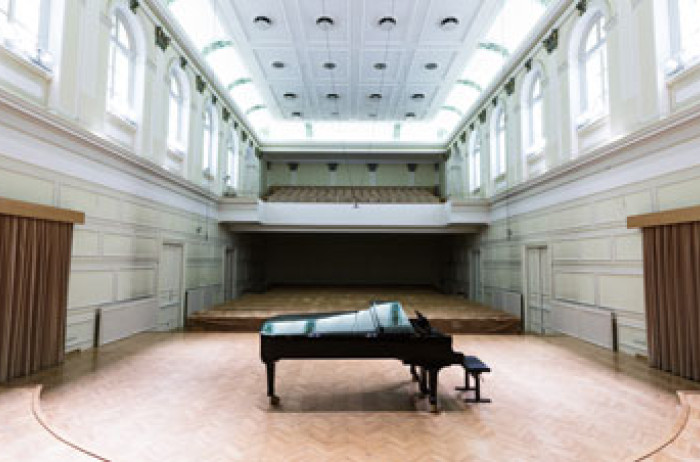Slovenian Philharmonic

© Bobo

© Dunja Wedam

© Dunja Wedam
The Slovenian Philharmonic (Slovenska filharmonija) is one of the world's oldest institutions of the kind. Its rich history dates back to 1701 when the first musical association and main promoter of Baroque music in Slovenian inhabited areas were established under the name of Academia Philharmonicorum. In 1794 the Academia was succeeded by the Philharmonic Society, the Slovenian Philharmonic's immediate predecessor, whose members included composers such as Josef Haydn, Ludwig van Beethoven and Johannes Brahms, and the violinist Niccolò Paganini. Franz Schubert applied for the post of a music teacher and Gustav Mahler was one Academia's conductors between 1881 and 1882.
The Slovenian Philharmonic Building was constructed in 1891 on the foundations of the former Estate Theatre (Stanovsko gledališče), built in 1763 to mark Emperor Joseph II's formal visit to Ljubljana and destroyed in a fire in 1887. As a result of a competitive tender, the Graz-based Austrian architect Adolf Wagner was commissioned to develop the plans for the Slovenian Philharmonic Building. The building's façade was designed in the neo-Renaissance style with rounded corners characteristic of theatre buildings of the time. In 1937, the architect Jože Plečnik added an annexe at the back of the building and redesigned the back facade. The entire building was thoroughly restored in 2001.
Slovenian Philharmonic Orchestra
The Slovenian Philharmonic Orchestra has a proud tradition as the country's leading symphony orchestra. It lives up to its reputation with numerous guest appearances in European cultural metropolises and the United States, as well as concerts at important international festivals. The Orchestra has played with the world's biggest names in classical music including, among others, Carlos Kleiber, Riccardo Muti and Zubin Mehta. After its re-establishment in 1947, the orchestra was led by recognized conductors, among them by Bogo Leskovic, Samo Hubad, Lovro von Matačić, Oskar Danon, Uroš Lajovic, Milan Horvat, Marko Letonja and George Pehlivanian. Its current artistic director and chief conductor is maestro Philipp von Steinaecker, appointed in the season 2019/20.
Schedule
The Slovenian Philharmonic Box Office is open Mondays to Fridays 11:00-13:00, 15:00-17:00 and during the hour prior to each concert.
Accessible to persons with movement disabilities
- Designated path from the car park/public transport to the building
- Designated entrance for persons with movement disabilities
- Designated sanitary facilities accessible to persons with movement disabilities
- Adequate access to the building for persons with movement disabilities (hallways, staircase, lift, etc.)
- Accessible event space for persons with movement disabilities
- Accessible information desk/cash register for persons with movement disabilities
Contacts
Kongresni trg 10 1000 Ljubljana
Phone: +386 (0)1 241 08 00
Email: [email protected]
Web site: Slovenian Philharmonic
The Slovenian Philharmonic resides in a building, formerly called Tonhalle, built in 1891 on the site of the former State Theatre, which burnt down in a fire. It has a prime downtown location overlooking the Congress Square on one side and the Ljubljanica riverbanks on the other.
This highly respected musical institution is proud of its tradition, now more than 310 years old. The Slovenian Philharmonic Orchestra successfully continues the legacy of its predecessors and has gained wide acclaim at concerts in Slovenia and abroad.
The Slovenian Philharmonic building, which was fully renovated in 2001, features two halls, the smaller of which is quite often used for receptions. With open windows, guest can catch a view of the baroque Ursuline Church at the top of the square, and the adjacent seat of the Ljubljana University, an imposing building from the turn of the 20th century.
Contacts
Kongresni trg 10
1000 Ljubljana
Ljubljana
Phone: +386 (0)1 241 08 00, +386 (0)1 241 08 14
E-mail: [email protected]
POI konference:
http://www.filharmonija.si
Capacities
-
Rooms 2
-
Area size 161
-
Theater seats 471
-
Reception 150
Conference rooms
-

Marjan Kozina Hall
309 seats in the parterre and 162 seats at the balcony. A special feature is the imposing pipe organ.
-
Theater
471
-
Classroom
-
-
Reception
-
-
Banquet
-
-
Size of the room
-
-
Ceiling height
10.5
-
-

Slavko Osterc Hall
-
Theater
90
-
Classroom
-
-
Reception
150
-
Banquet
-
-
Size of the room
161
-
Ceiling height
6
-

